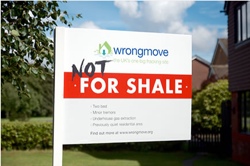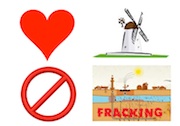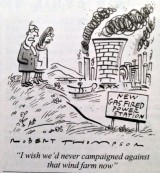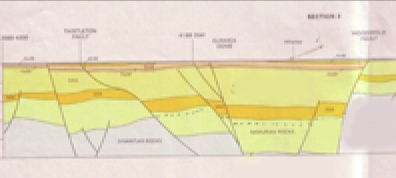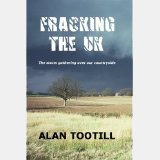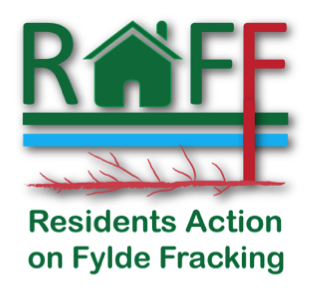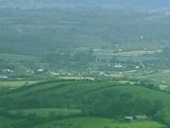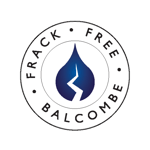Francis Egan – An apology
We feel we may have given the impression that Francis Egan was trying to mislead listeners in his radio interview with Radio Lancashire this morning. However, it has been pointed out to us that we may have been traducing a philanthropic benefactor.
Listening again to the interview we can confirm that he did make these two statements:
Well the total market value, so if you just take 10 % of the gas that’s in the ground and you multiply it by today’s gas price, the wholesale gas price not the gas price that you and I pay which is a lot higher than the wholesale gas price, it’s about £140 billion worth of gas, that’s just 10% of the gas that’s in the ground and we use that as what we believe is a reasonable conservative estimate of how much of the gas in the ground we might be able to get out of the ground.
and
The actual spend on any development itself would run into several hundred billions, most of which , we would hope would be spent in Lancashire.
We now realise, having looked at those quotes again, that Cuadrilla plan to run their shale gas extraction business at a loss as a service to UK PLC. It looks even more self-sacrificing if you use a more realistic recovery figure like 6%!
We therefore apologise unreservedly to Mr Egan for suggesting that his figure of “several hundred billions” might have been an exaggeration and we salute his community spirit. Perhaps the Queen might see her way to offering him a Geldof in return for his services to the poor
And with those sorts of numbers as a contribution to our economy, the £100,000 a development well and 1.4 billion as 1% of revenues look small beer. I think we can ignore them really.
What do you mean you already did?
Perhaps Maths Isn’t Mr Egan’s Strong Point
Interviewed this morning on Radio Lancashire Francis Egan, Cuadrilla’s CEO, made the absolutely astounding claim, that
“the actual spend on any development itself would run into several hundred billions, most of which , we would hope would be spent in Lancashire.”
The country’s biggest shale gas cheerleader, the Institute of Directors, say that a mammoth 10 well x 40 lateral pad would require £0.514 billion in total Capital Expenditure and Operating Expenditure over it’s entire (assumed 20 year) lifetime, and they only envisage 100 such wells UK wide. Their report would therefore indicate maximum spend of just £50 billion in the whole of the UK. Cuadrilla’s own website says they only need 10 such pads giving a total investment requirement of just £5 billion.
To suggest therefore that “the actual spend on any development itself would run into several hundred billions, most of which , we would hope would be spent in Lancashire.” is best described as fantasy (unless of course you can think of any reasons why Cuadrilla’s CEO might want to exaggerate the spend to make fracking seem more attractive)
Mr Egan then went on to say, when asked if shale gas would reduce gas prices
“Well forecasting gas prices is a difficult business as you know but if you increase supply, then it will push prices down of course, gas is just a commodity – it’s driven by supply and demand. If we can get more gas out of the ground its going to exert a downward pressure on price no doubt.”
This is an curious assertion given that Mark Linder, a public relations executive at Bell Pottinger who is also responsible for Cuadrilla’s corporate development told Greenpeace that “We’ve done an analysis and it’s a very small…at the most it’s a very small percentage…basically insignificant.” Most informed sources, including those being paid by his company have discredited the idea that shale as will reduce prices in Europe, but Mr Egan still takes the opportunity to suggest the opposite here. Why?
Having listened to this interview we have to ask why it is that Mr Egan constantly bemoans the fact that his company gets criticised?
Isn’t it rather obvious that if you keep deliberately misleading people they will eventually start to question everything you tell them?
Did we mention that Cuadrilla’s press release this morning contained the same claim that “Cuadrilla uses proven, safe technologies to explore for and recover natural gas” which was ruled to breach the Advertising Standards Authority code on misleading advertising, substantiation, and exaggeration?
You really couldn’t make it up.
When is a lie not a lie
When it’s in a press release!
Last Summer Cuadrilla made the claim in their “Community Newsletter” that
Cuadrilla uses proven, safe technologies to explore for and recover natural gas
Refracktion complained to the ASA about this statement and they duly adjudicated that
On this point, the claim “Cuadrilla uses proven, safe technologies to explore for and recover natural gas” breached CAP Code (Edition 12) rules 3.1 (Misleading advertising), 3.7 (Substantiation) and 3.11 (Exaggeration).
Roll on a couple of months and Cuadrilla’s press release this morning has a “Notes for Editors” section which begins
Cuadrilla Resources uses proven, safe technologies to explore for and recover natural gas reserves
We brought this to the attention of the ASA this morning and they replied
“as it’s a press release (which is not considered advertising) we can’t take action”
So Cuadrilla get away with making claims to the general public which have already been judged to be misleading by an objective 3rd party. What a wonderful regulatory system we have.
We do so hope that the regulations around fracking are a bit more robust. LOL
in the meantime editors obviously need to be careful of what they are told by Cuadrilla or they could end up facing complaints themselves.
Francis Egan reveals his plans on Radio Lancashire
Radio Lancashire Interviews as MP3 files here
74,000 Jobs from fracking. They’re having a laugh!
“I read the news today oh boy – 74,000 jobs in Blackpool, Lancashire”
OK well not quite. The Institute of Directors published their “big up the shale” report recently and one of the much repeated headlines was based on the claim that shale gas in the UK could create 74,000 jobs. Specifically the claim was that 100 10-well pads of 40 laterals could create “74,000 jobs in total (direct, indirect and induced – around twice as high as our previous estimate)”. Well, not only twice as high as their previous estimate but 10 times higher that the number of jobs which the previous report which Cuadrilla sponsored – Regeneris’ “Economic Impact of Shale Gas Exploration and Production in Lancashire and the UK” which estimated a high end scenario of 6,600 jobs UK wide from gas extraction by Cuadrilla.
Now bearing in mind that Cuadrilla expect to be able to supply 0.75 tcf a year, and the IoD estimate that total UK production is likely to be between 0.85 and 1.4 tcf it would not be unreasonable to extrapolate from Regeneris’s conclusions that there might be 10,000 jobs at peak (direct, indirect and induced) UK wide as a result of fracking.
So how on earth do the IoD come to their 74,000? We couldn’t work it out so we asked the report’s author, who told us:
Firstly, regarding the Regeneris report, I have not seen the detailed model that lies behind their report, so I can’t really comment. Their report did, however, assume a far lower number of wells (and consequently investment) than our report, so it is not surprising that the job estimates were considerably lower.
Secondly, the UK-level jobs estimate – of 74,000 direct, indirect and induced jobs at peak – presented in our report is actually quite modest when compared with the North Sea (339,000 direct, indirect and induced jobs in 2012, plus 100,000 jobs in the export of goods and services – see p.59 of our report) and the US (605,000 direct, indirect and induced jobs in 2012 – see p.81 of our report).
Thirdly, p.118 of our report explains our estimate of £1 million of capex and opex supporting 20 jobs in total (i.e. direct, indirect and induced). This is based firstly on the North Sea, where £17 billion of capex and opex in 2012 supported 339,000 direct, indirect and induced jobs (not including the 100,000 jobs exporting goods and services) at an average of £50,147 of expenditure per job. And secondly, on the US shale gas industry, where, according to the models developed by IHS, each $1 million (around £650,000) of capex supports 19 jobs in total – direct, indirect and induced. That works out at just over £34,000 capex per job. If you then make an allowance for operating expenditure, a total of close to £50,000 capex and opex per job is also reached.
Firstly we disagree with the conclusion that the Regeneris report has a lower estimate of jobs because it assumed a lower number of wells – what is important in terms of number of jobs is not the number of wells but the number of pads. Drilling more lateral wells from a pad may increase the length of employment but not necessarily the number of jobs.
The Regeneris report assumes 80 well pads and suggests 6,600 jobs. The IoD report assumes 100 pads and suggests 74,000 jobs
Something is awry somewhere there we think.
So what about this calculation which suggests that you can predict the Capital and Operational expenditure and divide each £1 million invested by 20 to get an accurate estimate of jobs? The author seems to think that the fact that he can get this 20 jobs per £ million invested from both the UK offshore and USA onshore data it must be valid for UK onshore. Frankly this is preposterous.
It is estimated that drilling costs (and therefore investment in Capex and Opex) off shore are between 10 and 20 times what they would be on shore. A conservative estimate by the UK Parliament Energy and Climate Change Select Committee suggest that “Offshore well costs are typically a factor of 10 higher than comparable costs for an onshore well”. meanwhile as reported in Canada – “Drilling offshore is extremely expensive, 10 to 20 times more than drilling onshore,” said Larry Hughes, a Dalhousie University professor who researches energy security.
This is one reason why nobody is currently looking to exploit the large shale gas reserves under the Irish Sea.
If investment costs are indeed 10-20 times as high offshore then logic suggests that the same investment onshore should generate 10-20 times as many jobs. The IoD should therefore be predicting a huge jobs bonanza of between 3/4 million and 1.5 million jobs. Curiously they are not doing so. Maybe that would be stretching our credulity a bit too far?
What about the USA figures – well Greenpeace suggest that “The IEA believes extracting the gas in Europe is between two and three times more expensive thanks to different geology and regulation.”
Using the same logic if we have to invest 2 to 3 times more then our employment rates would fall to between 6 and 10 jobs per £1 million invested.
To put it another way, using the jobs per £1 million invested data from USA onshore and UK Offshore but modifying it to take the necessary account of relative cost structures could give you a range anywhere between 6 and 400 jobs per £1 million invested. This is such a wide range as to be demonstrably meaningless.
Another illustration of the serious flaw in this logic is the suggestion in the report that a 40 well pad would result in 3 times the number of jobs that a 10 well pad would and for 5 years not 2. This is clearly out of line with reality as you don’t need many, if any, more people to drill the extra 30 wells. You just need the same people for longer. Extrapolating using the capex/opex calculation does lead to this sort of curious prediction though.
So do we believe the IoD estimates? No. We believe that even the Regeneris report may be overstating the case by predicting 2,500 jobs at the Lancashire level. We think that to get anything like a reliable estimate of employment potential you need a far more scientific method than this crude expenditure divisor.
If we have misunderstood something, and the IoD respond to our further queries with something more meaningful to substantiate their claims we’ll be sure to let you know, but until then we suggest a large pinch of salt should be taken before swallowing the employment predictions in the IoD’s report.
Why Cuadrilla really stopped work in Lancashire 2 months ago
Two months ago we posed the question of why Cuadrilla were claiming to be voluntarily delaying their drilling at Anna’s Road
Now, they had been waiting rather impatiently for nearly 2 years for the unofficial ban on fracking to be lifted. They messed up their drilling at Anna’s road and wasted 3 more months. They expect us to believe that they are prepared to voluntarily go for another year without seeing a penny returned on their already massive investment just because they have suddenly converted to the idea of doing proper EIAs? Really?
It didn’t really stack up that a business which has yet to make any real return for its investors would wait another year because they now claimed to want to do proper Environmental Impact Assessments – especially as they had been going to some lengths to get important areas of the EIA’s excluded only weeks before.
Well it seems that the real reason is now emerging.
In the Times on Saturday, an article appeared which stated that Cuadrilla were likely to receive approval from the Environment Agency for 8 permits covering fracking at 3 new sites in Lancashire at the end of the month. Apparently the final decision will be made after “public consultation” – hmm they only have two weeks before the end of the month to start that consultation don’t they?
The most illuminating part of the article though was the revelation that:
Lord Smith revealed that the process had been held up by “one or two months” after Cuadrilla Resources claimed it should not be subject to tough regulations requiring it to monitor closely any contamination of aquifers after fracking takes place.
Cuadrilla’s plans for fracking involve blasting up to 8.5 thousand cubic metres of water as well as toxic chemicals and proppants into the shale to make the gas flow.
Between 20-50% of the fracking fluid flows back to the surface, having picked up some nasty carcinogens and other hazardous material whilst underground, and also becoming mildly (that’s 90 times the permitted disposal level without a permit) radioactive. The rest remains under ground. There is a danger that any failure in well integrity might lead to the contaminated fluid leaking into the local aquifer with the resulting contamination of the water.
It seems that Cuadrilla argued that the EU Mining Waste directive should not apply to the contaminated fracking fluids that remained underground. However, this directive makes it incumbent on operators to check on a regular basis that the fluid underground cannot and does not escape.
Under this Directive shale gas operators have to make absolutely sure that the underground fluid is under proper control, properly sealed and check that it continues to be the case for decades after fracking.
This is all right and proper as we can’t just have cowboys riding in, taking their profit and then abandoning the wells and leaving any clean up problems to us long after they’ve gone. It seems perfectly reasonable that if they want to build wells they have to be responsible for them.
In spite of initially fighting this ruling Cuadrilla have now had to accept that the Directive should apply.
Given Cuadrilla’s have sought to reassure the public that it is well nigh impossible for fracking fluid to escape. They say on their website
Importantly, Cuadrilla always has at least three layers of steel casing at depths where the aquifer is found. These casings – the surface casing, the intermediate casing and the production casing – are cement-sealed and extend hundreds of feet below the aquifer. This is a comprehensive safety feature of our well designs and prevents contamination of the ground water.
With that level of certainty we can’t really see why they had a problem with this – unless they are perhaps not as sure as that statement might suggest when it comes to having to back up their words with actions and hard cash?
However , we are pleased to see that the one of the disparate and rather uncoordinated band of regulators is at last taking meaningful steps to address some of the serious issues around the potential pollution which could arise from contaminated fracking fluids leaking into the environment.
Do we really look THAT stupid?
“BPC (Balcombe Parish Council) criticised Cuadrilla for using a Market Research Company that had conducted a survey in the village and had been disingenuous with parishioners about who had commissioned them and the purpose of the survey. Cuadrilla said if this happened this was against the instructions given to surveyors and gave assurances that they would not undertake another survey in the village without notifying the BPC. ”
And from Radio 4 today
“I mean Cuadrilla has to back up everything it says. It has to justify itself to the Health & Safety Executive, the Environment Agency. er. People can say lots of other claims about it and don’t have to back it up. I don’t accept that.”
Mr Egan – either you have no control over what your company is doing or you think we are idiots. Or maybe it’s both.
Your problem is that we are not idiots and we will not accept your glib PR spiel because we can see what you are really doing here.
Oh Canada!
What, you may ask has what happens in Canada got to do with fracking on the Fylde?
Well the EU is considering a draft Canada-EU Trade Agreement treaty which would “establish a fair and equitable treatment” obligation that outlaws any “breach of legitimate expectations of investors”.
In practice this means that any fracking company based in Canada might be able to challenge any fracking ban or moratorium on the basis that it has cost their investors money.
In fact they don’t really even have to be based in Canada
Under the proposed treaty, companies launching suits against EU countries over drilling restrictions would not need to be strictly ‘Canadian’.
“You can’t just set up a mailbox in Canada and say you’re a Canadian company,” Bernasconi-Osterwalder explained. “You need some presence there. But you could still be a US company that has invested in Canada and then invests in the EU.”
The American tobacco company Philip Morris has sued Uruguay over ‘fair and equitable treatment’ codes, under a treaty between Montevideo and Switzerland. It also sued the Australian government under a 1993 Hong Kong-Australia investment treaty.
As euractive.com explains “The public would not only pay for the related environmental and health damages, but also run the risk of having to pay compensation to Big Energy when communities say no to fracking.”
You can read Euractiv’s commentary here. http://www.euractiv.com/trade/draft-eu-canada-trade-treaty-thr-news-519595?utm_source=RSS_Feed&utm_medium=RSS&utm_campaign=EurActivRSS
We will post information about further developments and any actions to follow / petitions to be signed in due course.
Bribery – a bad misjudgement by the government
It’s fairly obvious that the proposed offer of community bribes wouldn’t be necessary if what was being proposed with fracking wasn’t a bad thing for the area. However, we think that the government may have miscalculated very badly in making it clear that they think they can buy off any opposition.
Consider this story, taken from the book What Money Can’t Buy: The Moral Limits of Markets by Michael Sandel.
For years, Switzerland had been trying to find a place to store its radioactive waste…. One location designated as a potential site was the small mountain village of Wolfenschiessen (population 2,100). In 1993, shortly before a referendum on the issue, economists surveyed the residents of the village, asking whether they would vote to accept a nuclear waste repository in their community if the Swiss parliament decided to build it there. Although the facility was widely viewed as an undesirable addition to the neighborhood, a slim majority (51 percent) of residents said they would accept it. Apparently their sense of civic duty outweighed their concern about the risks. Then the economists added a sweetener: suppose parliament proposed building the nuclear waste facility in your community and offered to compensate each resident with an annual monetary payment. Then would you favor it?
The result: support dropped to 25 percent. What’s more, upping the ante didn’t help. When the economists increased the monetary offer, the result was unchanged. The residents stood firm even when offered yearly cash payments as high as $8,700 per person, well in excess of the median monthly income.
It’s a classic example, Sandel writes, of the way that putting a price on something — in this case, civic virtue — can actually change and even destroy it. Apart from the market, accepting the location of the storage site is virtuous; with the market, it’s simple bribery. In fact, “83 percent of those who rejected the monetary proposal explained their opposition by saying they could not be bribed.”
Seeing the way in which grubby politicians like Peter Lilley assume that we are for sale to the highest bidder makes people extremely angry.
We feel that he is judging me by his own dubious standards and we don’t like it.
Let’s make sure that we in the Fylde show we are not for sale either.
If fracking is so wonderful they need to come here to explain why. They need to try to persuade us not to buy us.
We think they know they can’t do that so instead we have the prospect of Conservative party grandees sitting in Whitehall offering grubby little sweeteners in a misplaced attempt to short-circuit the democratic process.
Shame on them!
Post Script – we thought it would be amusing to work out how much it would cost the government each year to try to bribe each and every resident of Fylde, Wyre, Ribble Estuary and Blackpool with a sum equivalent to $8,700. It turns out to be £2.1 TRILLION.
Community benefit? They’re having a laugh!
This week the press seem to have decided that fracking is all about “community benefits”. Scratch just a little at this nasty little scab and you will see that it covers the festering reality that fracking is going to be so unacceptable that they have to bribe us – and they think they can do it without trying too hard!
To quote Peter Lilley:
So now we need to give those living in the areas where drilling may take place an incentive to look critically at environmentalist propaganda. A cut in their energy bills should do the trick.
Such certainty Peter but such rubbish. It’s not “environmentalist propaganda” you have to worry about but an increasingly well informed public who won’t sell their birthright to you or our pals in the energy industry.
Here is another of the usual suspects, Simon Walker of the Institute of Directors blowing hard in the FT
Sir, It is absolutely vital for the development of Britain’s shale gas industry that local communities share in the financial benefits
There are several potential routes to ensure this happens. Pennsylvania, for example, charges a $45,000 “impact fee” for each shale gas well, which is split between the state government and county and municipal authorities. In the UK, it is also worth considering adapting the Community Benefits Protocol, launched two years ago for onshore wind developments, which guarantees a minimum annual payment per megawatt of installed capacity for the lifetime of the project…
Simon Walker, Director General, Institute of Directors, London SW1, UK
Let’s just think about that shall we?
With a $45,000 impact fee per well and 800 wells that would make $36,000,000 or £23,000,000. If that sounds a lot consider that the population of Blackpool, Fylde, Wyre and Ribble Estuary is about 385,000 and it works out at about £60 a head. How desperate does he think we are?
That’s probably not even enough to buy a mess of pottage at the West End restaurants next to his office.

